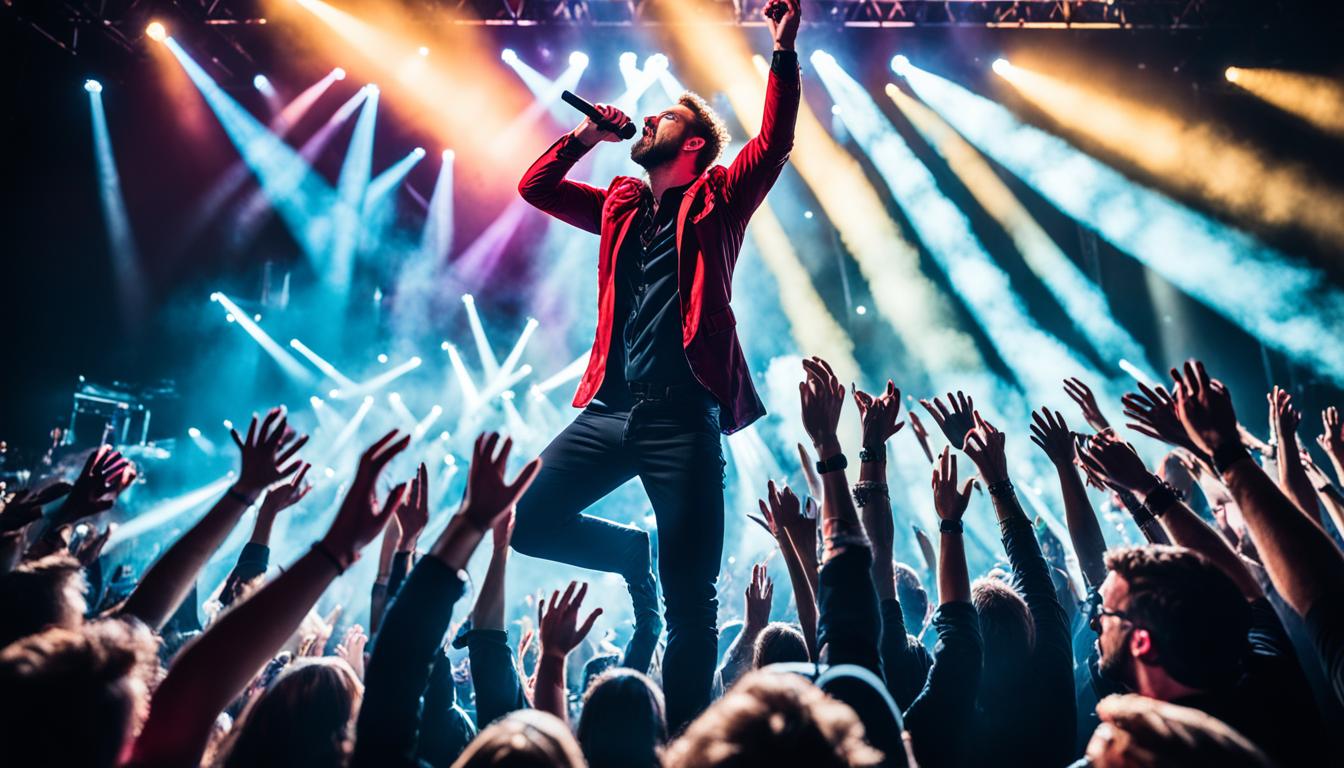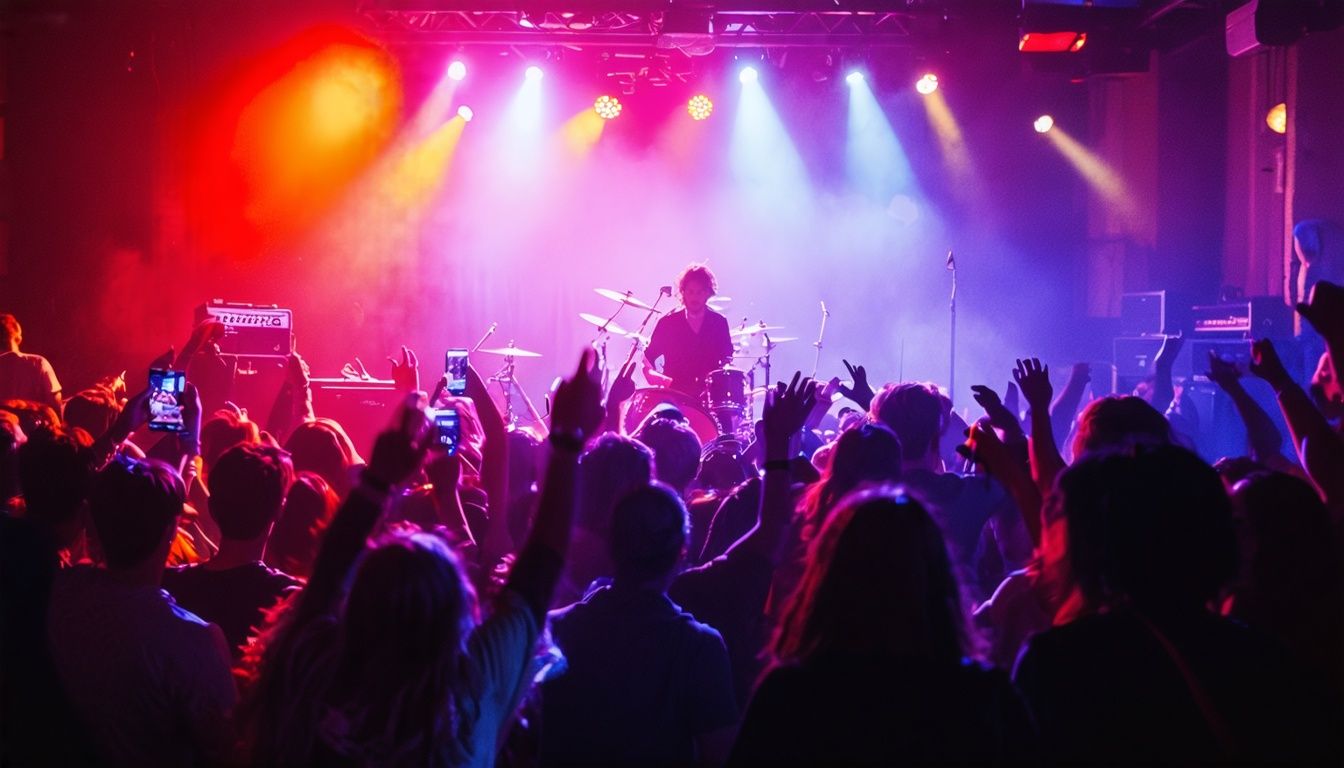We live for those thrilling moments when music and photography unite. This fusion creates a visual symphony loved by many. In our journey to build a portfolio in concert photography, we look up to photographers like Radek Zawadzki. His experiences teach us how to capture the magic of live shows. We learn the art of creating a standout concert photography portfolio filled with stage energy.
Following best practices for concert photography portfolios helps us tackle challenges and celebrate wins. We aim to capture the artists’ fervor and the concerts’ electric atmosphere. This journey teaches us to capture the essence of these events. We can then create a portfolio that showcases our skill and captures viewers’ and professionals’ hearts.
Key Takeaways
- Understanding the foundational steps to building a portfolio in concert photography.
- Learning and implementing concert photography portfolio tips from industry professionals.
- Embarking on the path of creating a standout concert photography portfolio through dynamic live event coverage.
- Discovering the best practices for concert photography portfolios to enhance visual storytelling.
- The importance of capturing the essence of live performances for a persuasive portfolio.
- Emphasizing the role of passion and perseverance in the concert photography arena.
Starting Your Journey in Concert Photography
Starting as a music photographer is exciting. It turns a passion into a profession. Like Radek Zawadzki, who turned his love for music into a career in photography, we too can make our mark. We do this by capturing the energy of live shows. This helps us build a strong set of photos that show our style and skill.
The Early Stages: From Passion to Profession
Starting in concert photography might begin in unexpected places. Taking photos at local shows and working with newspapers is a great first step. It teaches us how to present our work and sets our professional and creative standards. At first, we might only get small jobs. But these small gigs help us build a portfolio that opens doors to bigger opportunities.
Essential Equipment for Concert Photography Beginners
To start taking concert photos, you need the right tools. Here’s what you need to capture those amazing stage moments:
| Equipment | Function/Purpose | Why It’s Essential |
|---|---|---|
| Camera Suited for Low-Light | Capturing crisp images under stage lighting | Most concert scenes have low light. So, you need a camera that can handle that. |
| Versatile Lenses (24-70mm, 70-200mm) | Offering a range of shots from wide angles to close-ups | Having different lenses means you can take many types of photos, showing off your skills. |
| Prime Lens | For exceptionally dark settings | A prime lens works great in very dark places because of its fast aperture. |
| Ear Plugs | Hearing protection | Loud music can hurt your ears. Ear plugs keep your hearing safe while you work. |
Navigating the Local Music Scene: Finding Your First Gigs
Getting known in your local music scene is key to a good start. We suggest going to all kinds of music events, not just your favorites. This helps improve your skills and makes your portfolio interesting to more people. Remember, it’s important to capture the music’s feel and the artists’ passion. This needs commitment and the ability to adapt.
Success in concert photography starts with loving music and wanting to improve. It’s about making a portfolio that shows what you can do. Use every chance, even small ones, to practice and share your work. With the right efforts, small gigs can lead to bigger stages. That’s where your true talent shines.
Building a Portfolio in Concert Photography
In the world of concert photography, making a great portfolio is key. It’s not just about gathering photos, but telling a story. Your portfolio is how you show your vision to the people you want to amaze.
A great portfolio is your chance to speak without words. It brings the live event’s thrill to life and shows your skill in capturing moments. Each photo proves your knack for stopping time and sharing feelings, showing the concert’s vibe and your personal touch.
To stand out in the industry and make a great portfolio, you need to pay attention to details. Picking photos that show your best skills, imagination, and how you handle live concerts will show you’re ready for the big leagues.
Creating this collection means always striving to be better. Here are some tips to make a portfolio that matches your artistry and the concert photo world:
- Pick images carefully, showing variety in performances and photography techniques.
- Make your portfolio tell a story that clients can easily understand.
- Always critique your work, aiming to get better with every concert you photograph.

Choosing the right images can be tough. We’ve made a short guide to help. It’s your first step toward a portfolio that stands out, showing your potential and getting you into big events.
| Aspects to Highlight | Why It’s Important | Examples |
|---|---|---|
| Dynamic Lighting Scenarios | Shows how well you handle complex concert lighting. | Spotlight solos, silhouettes, and strobe-lit crowd shots. |
| Emotion and Atmosphere | Reveals how you capture the concert’s mood. | Close moments between artists and fans, expressive musician portraits. |
| Composition and Perspective | Proves your eye for capturing unique shots. | Close-ups of instruments, wide stage views, and creative angles. |
We don’t just take pictures; we capture moments full of music, crowd whispers, and the magic of live shows. Making a concert photography portfolio is an art. It means sharing these wild moments with the world.
To shine in concert photography, it takes our experiences and passion for the craft. Our work tells our story. And it’s that story that will open the door to capturing not just photos, but the memories and energy of live concerts.
Crafting Impactful Concert Photography
Exploring the art of optimizing your concert photography portfolio shows us its complexity. It’s about more than just taking pictures. We aim to capture moments that vividly bring live music to life. Achieving this involves mastering the dance of light and shadow.
The thrill begins when the stage lights up, and you’re there with your camera. It’s about making quick choices, adapting to changing lights, and predicting the performer’s moves. This skill is built on experience and a deep feel for the concert vibe.
Our objective is not simply to photograph what we see, but to convey the experience of being amidst the roaring crowd and the pulsing music. It’s the achievement of storytelling through visual means.”

- Curate with Purpose: Include only the best shots that showcase your skill diversity. Each photo should capture a unique part of the concert feel.
- Quality Over Quantity: Avoid filling your portfolio with too much. A selection of high-quality images tells a better story.
- Storytelling through Sequences: Arrange photos to tell the gig’s story as it unfolds.
To stick to best practices for concert photography portfolios, keep learning and evolving. Try new angles or capture behind-the-scenes moments. This gives a new view beyond the main show.
| Challenge | Solution | Impact on Portfolio |
|---|---|---|
| Varying light conditions | Adapt camera settings swiftly; Use manual mode | Demonstrates technical adaptability |
| Crowded spaces | Scout for unique vantage points | Contains dynamic and varied compositions |
| Restricted access | Network to secure better positions | Exhibits a diverse range of shots |
| Common ‘three songs, no flash’ rule | Maximize the limited time; prioritize shots | Portrays an ability to work under pressure |
Creating a portfolio that impresses fans and pros alike is tough. It’s a journey filled with passion, patience, and continuous effort. With every concert, we get closer to a powerful collection. This gallery proves our skills and captures the spirit of live music.
Making Connections and Securing Photo Passes
As concert photographers, moving up to big arena shows is a big step. It’s key to first do well in smaller venues. These places let us capture the whole show in a less stressful setting. This helps build a strong portfolio that’s ready for larger venues. It’s also critical to build industry relationships and know how to get photo passes.
From Local Venues to Big Arenas: Stepping Up Your Game
Moving up in concert photography requires skill and a good history. Working in local venues prepares us for the challenges of big events. Here, we can try different shots and lighting, teaching us valuable lessons. This experience is like stepping stones, helping us impress big venue stakeholders.
Networking Tips: Bonding with Bands and Publicists
Developing strong bonds with bands and their publicists is crucial. Connecting with them through messages or local media can open doors. This could lead to special access for candid photos. Candid shots add depth to your portfolio, showing the real side of performers.
Access All Areas: What You Need to Know About Photo Passes
Getting photo passes is key in concert photography. This step involves negotiation with publicists and media, where our portfolio plays a big role. Knowing the rules like ‘first three, no flash’ is important. These passes allow us to capture and share the energy of live concerts.
Showcasing Your Concert Photography Work
As photographers, we love the rush of live music. It’s crucial to create a standout concert photography portfolio. It’s not just about collecting photos. It’s about telling a story that shows our love for concert photography. Let’s talk about how to make our work stand out.
Choosing the Right Platform for Your Portfolio
First, we need to pick the right platform. It should reflect our style and make showcasing your concert photography skills easy without losing the depth of our work. It must be user-friendly, offer great support, and let us customize our online gallery.
Optimizing Your Concert Photography Portfolio for Engagement
We want to grab people’s attention with our portfolio. We choose photos that show the energy of concerts and the small, special moments. Our selection includes wide shots, close-ups of artists, and interactions with the audience. This shows off our range.
Leveraging Social Media to Enhance Your Profile
Our main portfolio site is key. But, we also use social media to reach more people. Platforms like Instagram and Twitter are great for sharing concert photography portfolio examples. They help us connect with more fans of music and photography.
Best Practices for Your Portfolio’s Online Presentation:
- Choose a platform that suits your style and needs.
- Show you can capture different concert vibes.
- Make sure your portfolio is easy to navigate and clean.
- Keep adding new, relevant content to your site.
- Smartly use social media to showcase concert photography work, but don’t rely on it too much.
To show how to showcase concert photography work well, here’s a table with key parts for your online portfolio:
| Portfolio Element | Description | Impact on Engagement |
|---|---|---|
| Stunning Visuals | High-resolution images that capture the concert’s spirit. | Makes people stop and look, keeping their interest. |
| Intuitive Design | Easy-to-use layout that makes your work shine. | Encourages people to see more of your portfolio. |
| Diverse Content | Showing various music genres and concert settings. | Proves your flexibility as a photographer. |
| Artist Collaboration | Working together with musicians or bands on projects. | Demonstrates your ability to handle unique projects. |
| Testimonials | Positive reviews from clients or photo subjects. | Helps build trust and credibility with potential clients. |
In conclusion, spending our days capturing live music’s essence is just part of our job. Success also comes from how we show our work. By picking the right platform, making our portfolios engaging, and using social media wisely, we can make our work as impactful as the concerts we shoot.
Conclusion
In the thrilling world of concert photography, we’ve faced challenges and celebrated wins. Our journey began in dim, local venues and led us to big stages. This path is fueled by a love for music and capturing its essence. Every concert and photo pushes our skills further, enriching our work.
Chasing the perfect shot, we’ve leaned on key tips to guide us. These insights teach us to capture live performances and build strong music industry connections. Success mixes showcasing our talents and forging a standout portfolio. Our work shows our technical skills and our growth story.
With every concert, we capture more than images. Each photo reflects our commitment to the craft. Behind each image are stories of melodies and timeless moments. Our portfolio, rich with creativity and strategy, lets us highlight the vibrant world of live music. It shows our deep connection to concert photography.
FAQ
How do I start building a portfolio in concert photography?
Start by taking photos at small local shows where you don’t need a pass. Catch different kinds of music, lighting, and emotions in your pictures. This shows your range and skill.
What are some essential tips for creating a standout concert photography portfolio?
Your portfolio should not only show your skill but also the feeling of being there. Include photos with strong emotions, lighting, and crowd scenes. Be selective and showcase your best images.
What equipment do I need as a beginner in concert photography?
Start with a camera good in low light, a 24-70mm and a 70-200mm lens, and a prime lens for very dark places. Wear ear plugs to protect your hearing. A ladder can help get better shots.
How do you showcase concert photography work effectively?
Present your photos on a professional website you control. Use social media to reach more people, but focus on your website for the best display of your work.
What are some best practices for concert photography portfolios?
Update your portfolio with new photos often. Show different music styles and venues. Make sure it’s easy to use and loads fast. Have your contact info easy to find. Put your most impressive work first.
How can I make connections and secure photo passes for bigger concerts?
Meet bands and publicists at shows and through local media. Start by showing great work at smaller venues. Then, use those connections to get passes for bigger events.
What should I know about optimizing my concert photography portfolio for engagement?
Add different kinds of photos to your portfolio, like shots of the whole venue, backstage, and close-ups of artists. A varied and striking portfolio attracts more viewers.
What are the rules I should be aware of when photographing concerts?
Learn rules like “first three, no flash,” meaning shoot only the first three songs without flash. Always follow the rules from the venue or artist’s team.
How do I choose the right platform for my concert photography portfolio?
Choose a platform made for photography with a user-friendly design and good support. It should make your work look great and be easy for viewers to use.
Can I use social media as my primary platform for my concert photography work?
Social media is good for getting noticed and making connections, but don’t rely on it alone. Use it to bring people to your main portfolio website.



